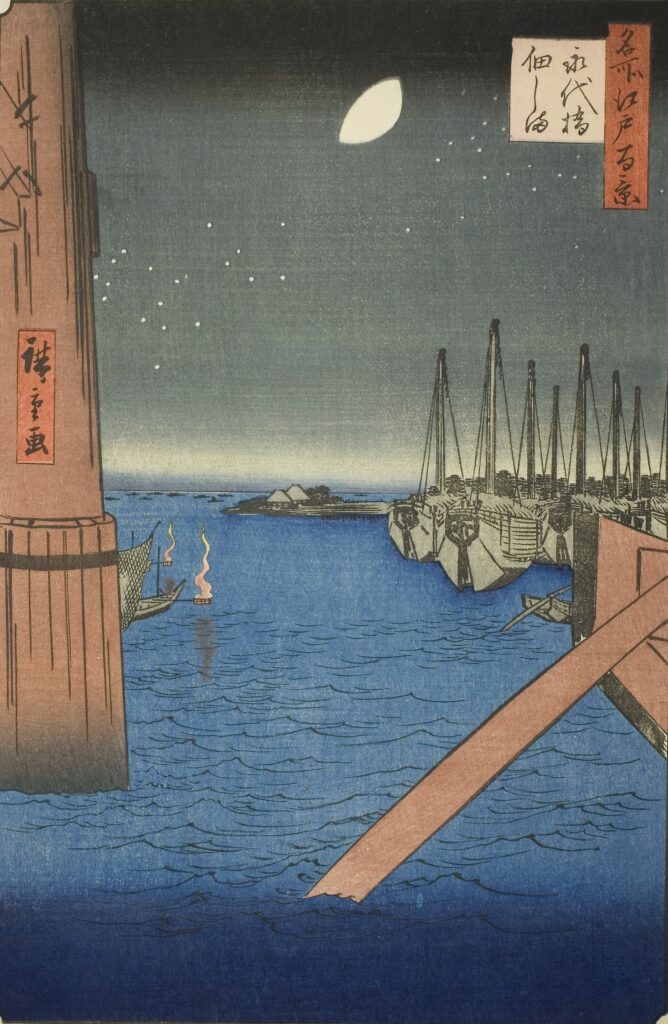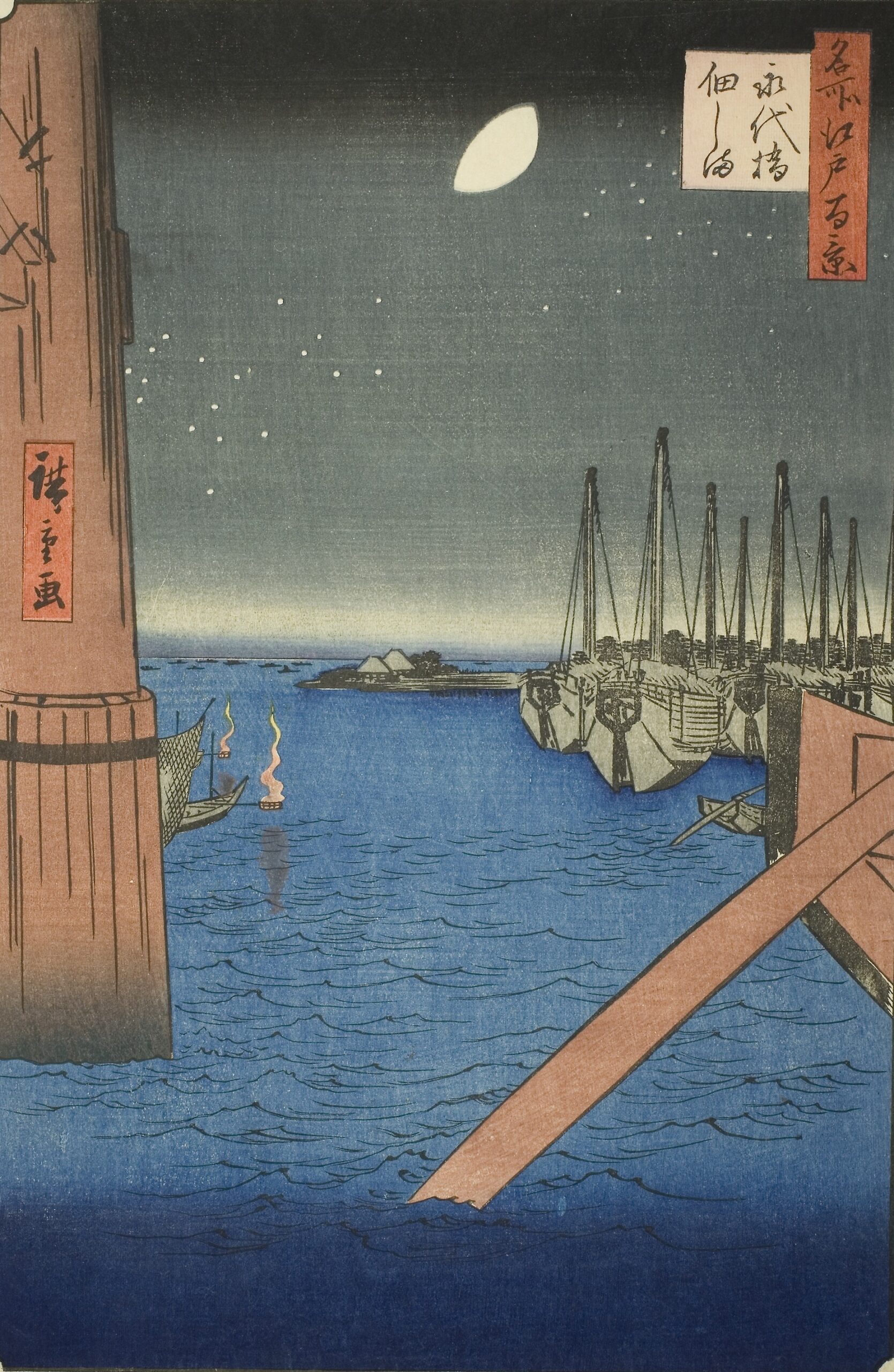
Utagawa Hiroshige – One Hundred Famous Views of Edo – 4 – Spring – Eitaibashi Bridge and Tsukuda Island 歌川広重-名所江戸百景-4-春-永代橋佃しま 解説
Current Address: Eitaibashi Bridge, Saga 1-chome, Koto Ward
Latitude and Longitude: Latitude 35.6718, Longitude 139.7926
Published: February 1857 Age: 61
Explanation
<1> Introduction
“Eitaibashi Bridge and Tsukuda Island” is a work depicting the Eitaibashi Bridge spanning the Sumida River and Tsukuda Island on the opposite bank.
Skillfully capturing the waterfront landscape where the river and sea meet, it depicts a typical Edo landscape where fishing villages and cities coexist.
<2> About Eitaibashi Bridge and Tsukuda Island
Eitaibashi Bridge was built in 1698 to celebrate the 50th birthday of the fifth shogun, Tokugawa Tsunayoshi.
This bridge is approximately 200 meters long and 6 meters wide, stretching from Hakozaki, the most downstream point on the Sumida River, to Fukagawa Sagacho.
It is one of the important bridges spanning the Sumida River, the Okawa River in Edo.
It is said to have been named after the bridge that spanned Eitaijima Island.
In 1807, the bridge collapsed when a group of people attempting to cross it to watch the Fukagawa Hachiman Festival, resulting in approximately 1,500 deaths and injuries.
It became a major transportation route from Nihonbashi to Fukagawa.
Eitaibashi Bridge is more than just a transportation hub; it is also a popular spot for viewing fireworks and other events.
It was rebuilt as an iron bridge during the Meiji period and remains a landmark on the Sumida River today.
Tsukudajima Island was established in 1624 by fishermen who immigrated from Tsukuda Village, Nishinari County, Settsu Province (present-day Tsukuda, Osaka City).
Granted fishing rights to present fish to the shogunate, the island flourished as a fishing village essential to Edo’s food culture.
Tsukudani, a preserved food, originated on this island. Tsukudani adorned the tables of Edo commoners and continues to be loved throughout the country today.
Sumiyoshi Shrine is enshrined on the island, and the island is revered as a place of faith, praying for safe voyages and prosperity in the fishing industry.
Even today, a portable shrine is carried through the island during summer festivals, carrying on a tradition that has continued since the Edo period.
<3> Highlights of the painting
The large Eitai Bridge in the center of the painting is depicted in a form that gives a real sense of the scale of the Sumida River.
Its length and the way it spans the mighty river are depicted with great impact as a symbol of Edo’s infrastructure.
Spreading across the opposite bank is the fishing town of Tsukudajima.
Rows of low-slung houses reveal living spaces facing the sea.
This clearly shows that a fishing village landscape existed right next to the city of Edo.
Boats of all sizes ply the Sumida River, indicating the thriving transportation of goods and fishing industries.
The river was Edo’s “artery,” supporting the lives of ordinary people and the urban economy.
There is a hint of the ocean stretching out on the other side of the river, and the dynamic topography where river, sea, and city intersect can be felt.
The photo shows Tsukudajima viewed from the piers of Eitai Bridge. Whitebait fishing is taking place behind the piers, and a benzai boat is moored to the right. The stars and moon shine in the night sky, illuminating the sea surface.
The back of the boat in the center right is Tsukudajima. The boat in the center right is a benzai boat.
The four-way net is in the center left. The boat next to the four-way net is a whitebait fishing boat.
The thick wooden structure in the center left is Eitai Bridge.
<4> The Appeal Felt by the Common People of Edo
Eitai Bridge was an important passageway connecting the Fukagawa and Kiba areas with central Edo. It was a bustling gateway for the transportation of goods.
Seafood and tsukudani (food preserved in soy sauce and preserved in soy sauce) brought in from Tsukudajima supported the food culture of the common people of Edo.
A fresh supply of river and sea fish was a luxury unique to Edo.
The view of the Sumida River and Tsukudajima from the bridge also made it a popular tourist spot.
The silhouette of the island, particularly at dusk and in the morning mist, is particularly picturesque, making it a suitable subject for ukiyo-e prints.
<5> The Modern Eitai Bridge and Tsukudajima
The current Eitai Bridge is an arched iron bridge completed in 1926.
Designated a National Important Cultural Property, it is beautifully lit up at night.
A vestige of Tsukudajima can be seen in the modern high-rise apartment complex “Tsukuda River City 21.” Meanwhile, Sumiyoshi Shrine, narrow alleys, and old houses remain, conveying the atmosphere of Edo’s fishing village.
Sumida River Terrace has a well-maintained promenade along the river, making it ideal for walking and cycling.
<6> Sightseeing Guide
1. Eitai Bridge Illumination
The arch bridge illuminated in blue and white lights is a must-see and a popular photo spot.
2. Sumiyoshi Shrine
The guardian deity of Tsukudajima, Sumiyoshi Shrine has been a center of faith since the Edo period, and its summer festival is a spectacular sight.
3. Tour of Long-Established Tsukudani Shops
Experience Edo food culture by tasting tsukudani, a specialty of Tsukudajima.
4. Sumida River Cruise
The view of Eitai Bridge and Tsukudajima from the boat brings the world of ukiyo-e to life in the modern day.


